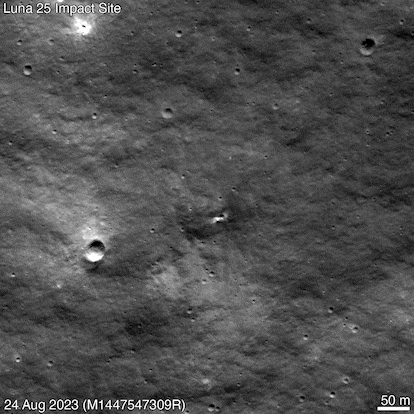Why is it so difficult to land on the moon?
Japan’s ‘SLIM’ spacecraft executes a challenging landing, showcasing the complexity of this remarkable achievement

Japan’s recent lunar landing, becoming the fifth nation to complete a soft landing after India last August, showcased the challenges of returning to the moon. The moon lacks air, of course, making parachute deployment impossible. Only rocket engines can be used, requiring precise adjustments to achieve a near-zero speed touchdown. Landing on the moon is a complex task that requires radar and laser measurements to monitor altitude and carefully manage fuel consumption. The objective is to avoid premature depletion while ensuring a safe landing without any horizontal displacement. And the delicate onboard instruments must be protected from potential damage upon impact.
The challenge is such that NASA has chosen to delay the Artemis program, pushing back its crewed lunar landing until at least 2026. Uncrewed landers have also met with frequent failure. In the past decade, no privately-funded attempts have succeeded, with only China and India making successful soft landings.
What happened with the most recent failed landings?
Chandrayaan 2 crashed due to an error in the descent control software. Russia’s Luna 25 crashed due to a failure in its braking system. Israel’s Beresheet experienced a central computer reset at a low altitude, preventing recovery and engine restart. The radar system on Japan’s Hakuto-R radar misinterpreted the steepness of a crater wall. The American Peregrine lunar lander had a fuel leak from a stuck valve, leading to mission failure. But India’s Chandrayaan 3 successfully landed in the south pole of the moon. Chastened by previous failures, the Indian engineers rewrote much of the software for the landing routines. They adopted Murphy’s Law as their motto: “Everything that can go wrong, will go wrong.” With this premise, they accomplished the remarkable feat of becoming the fifth country to land on the moon.
Weren’t there any crashes 50 years ago?
Absolutely. It took the Soviet Union a dozen attempts to land the first capsule on the moon. And it was a very basic vehicle that made a hard landing protected by airbags. The first American attempts also ended in failure. The Ranger series of lunar landers made six tries before achieving success, even though those spacecraft were intended to be destroyed upon impact with the moon’s surface. While NASA achieved a successful soft landing with the Surveyor 1 probe on the first try, two of the six subsequent attempts failed.
The Chinese space program stands out with an impressive track record of success. They have achieved remarkable feats on their first attempts, including moon and Mars landings, rover deployments, and the complex task of bringing regolith (loose rock and dust) samples back to Earth. China’s missions have been accomplished by autonomous robots.
Can’t a moon landing be controlled from Earth?
No. A moon landing cannot be controlled from Earth because radio signals take a little over a second to reach us from the moon. The same goes for any signals sent from Earth to the spacecraft. Those three seconds of delay is too much time for precise operations measured in tenths of a second. Lunar spacecraft must be autonomous and make split-second decisions based on how the descent progresses.
Why do the landers now take months to travel to the moon?
The Apollo missions of the 1960s and 1970s reached the moon in just three days. However, the modern rockets used now have less power than the colossal Saturn 5. To optimize their performance, low-energy trajectories are employed, reducing the amount of fuel required. The trade-off is longer flight durations.
The Apollo missions followed a direct route to the moon, but current missions use elongated ellipses, gradually increasing their apogee through short propellant firings. These ellipses extend beyond the moon’s orbit, reaching distances of over a million kilometers. Recent missions leverage gravitational interactions between the Earth, moon and Sun to enter the moon’s orbit, requiring minimal fuel for braking if calculations are correct.
How did Japan’s SLIM landing go?
The SLIM (Smart Lander for Investigating Moon) spacecraft that landed on the moon on January 19 was executing an engineering test. The main goal was to achieve a precise descent, no more than 100 meters from the targeted landing spot. The navigation system had to locate the exact landing spot by instantly comparing snapshots of craters with images stored in memory. Artificial intelligence algorithms were used to identify the target landing area and make lateral movements in order to avoid obstacles.
The landing terrain was challenging — a 15-degree slope that would cause a traditional probe to overturn. SLIM was equipped with unique, five-legged landing gear mounted on its sides. This landing gear was designed to enable a vertical descent, but upon contact with the moon’s surface, it would tilt to deploy its instruments and the pair of rovers it was carrying.
While the landing was successful, Japan’s space agency said the SLIM’s solar battery wasn’t generating power and that it had only a few hours of battery life. The priority for the SLIM would be to gather as much data about its landing and the moon as possible on the remaining battery.
What robots were on board the SLIM?
There are two types of robots on board. One weighs two kilos and makes short jumps to move about. It’s also capable of direct communication with Earth. The second type is the size and weight of a tennis ball. Once on the ground, it opens into two halves that act as wheels and exposes a pair of mini-cameras. These cameras are so small they don’t have communications antennas, so they send images via Bluetooth to the larger robot.
The camera robot’s resemblance to a Transformer is no coincidence; it draws inspiration from the rich Japanese tradition of shape-shifting robots. Crafted by a toy factory commissioned by Japan’s space agency, this remarkable robot is a twin of the one sent aboard the ill-fated Hakuto-R. Had the SLIM’s battery not run out, this charming little gadget may have become the next must-have toy all over the world.
Sign up for our weekly newsletter to get more English-language news coverage from EL PAÍS USA Edition
Tu suscripción se está usando en otro dispositivo
¿Quieres añadir otro usuario a tu suscripción?
Si continúas leyendo en este dispositivo, no se podrá leer en el otro.
FlechaTu suscripción se está usando en otro dispositivo y solo puedes acceder a EL PAÍS desde un dispositivo a la vez.
Si quieres compartir tu cuenta, cambia tu suscripción a la modalidad Premium, así podrás añadir otro usuario. Cada uno accederá con su propia cuenta de email, lo que os permitirá personalizar vuestra experiencia en EL PAÍS.
¿Tienes una suscripción de empresa? Accede aquí para contratar más cuentas.
En el caso de no saber quién está usando tu cuenta, te recomendamos cambiar tu contraseña aquí.
Si decides continuar compartiendo tu cuenta, este mensaje se mostrará en tu dispositivo y en el de la otra persona que está usando tu cuenta de forma indefinida, afectando a tu experiencia de lectura. Puedes consultar aquí los términos y condiciones de la suscripción digital.











































